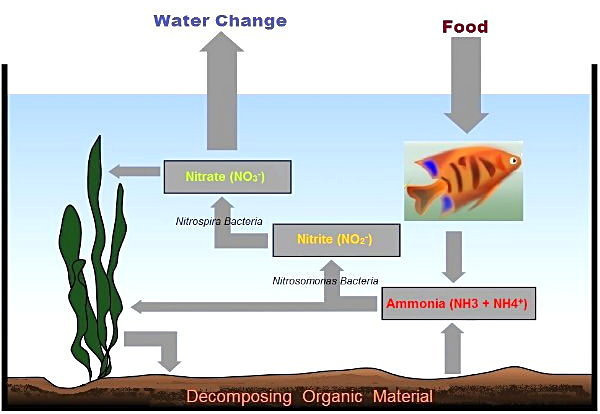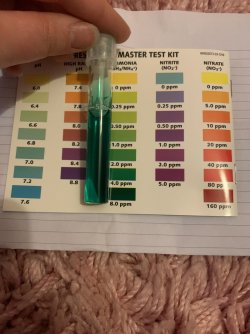That's the one I use  (Don't forget to set salinity to zero is you use it)
(Don't forget to set salinity to zero is you use it)
You are using an out of date browser. It may not display this or other websites correctly.
You should upgrade or use an alternative browser.
You should upgrade or use an alternative browser.
Cycle questions!
- Thread starter Emilywoodham1997
- Start date
-
- Tags
- cycling
The April FOTM Contest Poll is open!

🏆 Click to vote! 🏆
Emilywoodham1997
New Member
Thank you, my ammonia has just arrived! Should I just use the calculator as normal? Even though my tank is kinda “partly” cycled?
Don't use the calculator in ITViking's link to add ammonia - that's for working out the amount of toxic ammonia if there's an ammonia reading when there are fish in the tank.
To work out how much ammonia to add during cycling, use this calculator https://www.fishforums.net/aquarium-calculator.htm Ammonia is the last item. Enter the tank volume and it will tell you how many mls ammonia you need to add to get a reading of 3 ppm. If it's a small amount, a syringe is helpful. Pharmacies sell them - but ask for a babies medicine dose syringe or you'll get the third degree if ask for just a syringe (been there....) The make them as small as 1 ml.
Once you've added the ammonia, wait half an hour for it to mix in thoroughly then test for ammonia to check it's 3 ppm.
Then follow this method.

 www.fishforums.net
It should progress quickly as you've already grown some bacteria. Also, with some live plants in the tank there may well be less nitrite appearing as plants take up ammonia and don't turn it into nitrite.
www.fishforums.net
It should progress quickly as you've already grown some bacteria. Also, with some live plants in the tank there may well be less nitrite appearing as plants take up ammonia and don't turn it into nitrite.
To work out how much ammonia to add during cycling, use this calculator https://www.fishforums.net/aquarium-calculator.htm Ammonia is the last item. Enter the tank volume and it will tell you how many mls ammonia you need to add to get a reading of 3 ppm. If it's a small amount, a syringe is helpful. Pharmacies sell them - but ask for a babies medicine dose syringe or you'll get the third degree if ask for just a syringe (been there....) The make them as small as 1 ml.
Once you've added the ammonia, wait half an hour for it to mix in thoroughly then test for ammonia to check it's 3 ppm.
Then follow this method.

Cycling Your New Fresh Water Tank: Read This First!
Cycling Your First Fresh Water Tank What is Cycling and Why is it Important? Fish waste, and especially fish breathing, plus uneaten food and other organic matter breaking down in a tank all produce Ammonia. This can quickly become toxic to fish if it is allowed to build up to any measurable...
 www.fishforums.net
www.fishforums.net
Don't use the calculator in ITViking's link to add ammonia - that's for working out the amount of toxic ammonia if there's an ammonia reading when there are fish in the tank.
To work out how much ammonia to add during cycling, use this calculator https://www.fishforums.net/aquarium-calculator.htm Ammonia is the last item. Enter the tank volume and it will tell you how many mls ammonia you need to add to get a reading of 3 ppm. If it's a small amount, a syringe is helpful. Pharmacies sell them - but ask for a babies medicine dose syringe or you'll get the third degree if ask for just a syringe (been there....) The make them as small as 1 ml.
Once you've added the ammonia, wait half an hour for it to mix in thoroughly then test for ammonia to check it's 3 ppm.
Then follow this method.
It should progress quickly as you've already grown some bacteria. Also, with some live plants in the tank there may well be less nitrite appearing as plants take up ammonia and don't turn it into nitrite.
Cycling Your New Fresh Water Tank: Read This First!
Cycling Your First Fresh Water Tank What is Cycling and Why is it Important? Fish waste, and especially fish breathing, plus uneaten food and other organic matter breaking down in a tank all produce Ammonia. This can quickly become toxic to fish if it is allowed to build up to any measurable...www.fishforums.net
Thanks! I've removed my link so as not to lead anyone down the wrong path.
Emilywoodham1997
New Member
No, that will make too much ammonia. Follow the instructions in this method https://www.fishforums.net/threads/cycling-your-new-fresh-water-tank-read-this-first.421488/
@ITViking The link for the free ammonia calculator is very useful in fish-in cycling or where a cycled tank has a mini-cycle for some reason. Calculating the amount of toxic free ammonia enables the fishkeeper to allow total ammonia up to the calculated safe limit to encourage bacteria growth. Free ammonia at 0.05 is OK for a day or two; free ammonia at 0.02 is OK for a few days. But more than 3 or 4 days even at 0.02 free ammonia needs a water change.
@ITViking The link for the free ammonia calculator is very useful in fish-in cycling or where a cycled tank has a mini-cycle for some reason. Calculating the amount of toxic free ammonia enables the fishkeeper to allow total ammonia up to the calculated safe limit to encourage bacteria growth. Free ammonia at 0.05 is OK for a day or two; free ammonia at 0.02 is OK for a few days. But more than 3 or 4 days even at 0.02 free ammonia needs a water change.
Thanks! To make sure I have this correct, 'free ammonia' is NH3, right? So far I haven't seen a big uptake in the ammonia levels of the tank I'm cycling (5 weeks in now). I've only had levels of TAN ammonia low enough that they calculate into effectively 0.0 NH3. But my nitrites and nitrates have been higher - hopefully a sign I'm nearing the end. But I don't want to encroach on someone else's cycle thread - sorry OP.
Yes, sorry I should have explained my terminology.
As you know, our test kits measure ammonia (NH3) and ammonium (NH4+) combined, and this is called total ammonia. The NH3 part of total ammonia is often called "free ammonia" to distinguish it from ammonium.
There is a sticky in the Cycle Your Tank forum on fish-in cycling https://www.fishforums.net/threads/rescuing-a-fish-in-cycle-gone-wild-part-il.433778/ which includes using that calculator to work out how much of the total ammonia is NH3, and what levels are safe so you you know when to do a water change; and also how to mitigate the effects of nitrite using salt.
As you know, our test kits measure ammonia (NH3) and ammonium (NH4+) combined, and this is called total ammonia. The NH3 part of total ammonia is often called "free ammonia" to distinguish it from ammonium.
There is a sticky in the Cycle Your Tank forum on fish-in cycling https://www.fishforums.net/threads/rescuing-a-fish-in-cycle-gone-wild-part-il.433778/ which includes using that calculator to work out how much of the total ammonia is NH3, and what levels are safe so you you know when to do a water change; and also how to mitigate the effects of nitrite using salt.
DAnCSF
Fish Crazy
Golly life was so simple in the past, when we didn't know anything...here's a great video that I found about test kits and ammonia levels...Most test kits test for 'Total Ammonia Nitrogen' (TAN), but some will give a chart to see what the approximate NH3 (toxic ammonia) is. If your test kit doesn't do this, you can take the TAN reading you get from your test kit and then use an online calculator to get the NH3.
Ammonia test kits don't lie, it's that we don't understand them. There is no way that test kits can differentiate between ammonia and ammonium.
Ammonia and ammonium are in equilibrium with each other. The equilibrium constant determines the proportions of each that are present. The constant varies with pH. At pH under 7.0, very little is in the ammonia form while at pH above 7, more is in the ammonia form.
Ammonia and ammonium are in equilibrium with each other. The equilibrium constant determines the proportions of each that are present. The constant varies with pH. At pH under 7.0, very little is in the ammonia form while at pH above 7, more is in the ammonia form.
What I find kind of intriguing about ammonia test kits is that they are based on different methods. For instance, mine Fluval kit uses a modified Indophenol method. Given the time, I'd like to explore these methods in more depth to try to understand some of the issues involved and why certain methods are better than others.
Most seem to use the salicylate reaction - that's the one with yellow zero going greener as the amount of ammonia increases.


